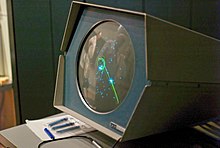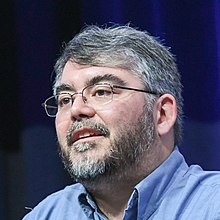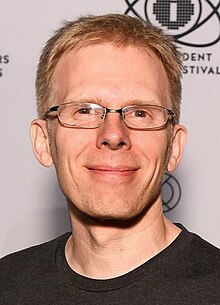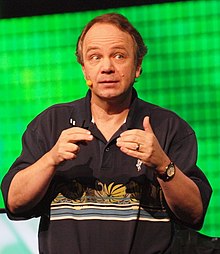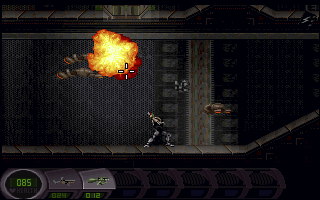Portal:Video games
Portal maintenance status: (April 2019)
|
The Video Games Portal

A video game, also known as a computer game or just a game, is an electronic game that involves interaction with a user interface or input device (such as a joystick, controller, keyboard, or motion sensing device) to generate visual feedback from a display device, most commonly shown in a video format on a television set, computer monitor, flat-panel display or touchscreen on handheld devices, or a virtual reality headset. Most modern video games are audiovisual, with audio complement delivered through speakers or headphones, and sometimes also with other types of sensory feedback (e.g., haptic technology that provides tactile sensations). Some video games also allow microphone and webcam inputs for in-game chatting and livestreaming.
Video games are typically categorized according to their hardware platform, which traditionally includes arcade video games, console games, and computer (PC) games; the latter also encompasses LAN games, online games, and browser games. More recently, the video game industry has expanded onto mobile gaming through mobile devices (such as smartphones and tablet computers), virtual and augmented reality systems, and remote cloud gaming. Video games are also classified into a wide range of genres based on their style of gameplay and target audience. (Full article...)
Featured articles – load new batch
-
Image 1Super Smash Bros. Melee is a 2001 crossover fighting video game developed by HAL Laboratory and published by Nintendo for the GameCube. It is the second installment in the Super Smash Bros. series. It features characters from Nintendo video game franchises such as Mario, The Legend of Zelda, Star Fox, Pokémon, and Donkey Kong among others. The stages and gameplay modes reference or take designs from these franchises as well.
Melee includes all playable characters from the first game and also adds characters from additional franchises such as Fire Emblem, of which no games had been released outside Japan at the time, in addition to new stages and gameplay modes. Like other games in the Smash Bros. series, Melee's gameplay system offers an unorthodox approach to the fighting game genre, with a counter that measures damage with increasing percentages, representing the knockback the character will experience, rather than a depleting health bar seen in most fighting games.
Melee was first released in Japan in November 2001, in the Americas in December 2001, and in Europe and Australia in May 2002. The game received widespread acclaim from critics, earning praise for its visuals, simple controls, gameplay, and orchestrated soundtrack, as well as several awards and acknowledgments from various publications; it is now considered one of the greatest video games ever made. It achieved strong sales upon its release, becoming the GameCube's best-selling title, with over seven million copies sold by 2008. Considered one of the most competitively viable Smash Bros. games due to its fast-paced and aggressive gameplay, Melee has been featured in many competitive gaming tournaments, boasting a dedicated grassroots fan community which has kept its competitive scene alive well beyond the game's original lifespan. It was followed by Super Smash Bros. Brawl for the Wii in 2008. (Full article...) -
Image 2Sinistar: Unleashed is a 1999 action space shooter video game for Microsoft Windows. It was designed by Marc Michalik and Walter Wright and developed at GameFX, a small studio composed of former members of Looking Glass Studios. Originally titled Out of the Void, development of the project began in 1997 and had no relationship with the Sinistar franchise. After licensing the franchise from Midway Games that year, GameFX shifted the focus of the game and developed it as a sequel to the original Sinistar, which was released by Williams in 1982.
Like the previous installment, Sinistar: Unleashed focuses on the destruction of the Sinistar, a large bio-mechanical machine, powered by machines called the Sporg. To achieve this goal, the player has a variety of starships, power-ups and weapons. Unlike its predecessor, the game has full three-dimensional graphics and a wider control scheme. Sinistar: Unleashed features 29 levels, five of which are hidden; each level has a Sinistar.
Sinistar: Unleashed received mixed reception when released. Critics lauded its audacity, as well as the addition of new features into the game. Several journalists felt that GameFX captured all the elements that represented a Sinistar game and stayed true to the franchise by feeling familiar to fans of the original game. However, critics faulted the boss designs and the repetitiveness of the gameplay. (Full article...) -
Image 3Outer Wilds is a 2019 adventure video game developed by Mobius Digital and published by Annapurna Interactive. The game follows the player character as they explore a planetary system stuck in a 22-minute time loop that resets after the sun goes supernova and destroys the system. Through repeated attempts they investigate the alien ruins of the Nomai to discover their history and the cause of the time loop.
The game began development in 2012 as director Alex Beachum's master's thesis. He was inspired to create a game focused on exploration in which the player character was not the center of the game world. Beachum led a small team in building the game, first as an independent project, then as a commercial game at Mobius after the project won the Excellence in Design and Seumas McNally Grand Prize awards at the 2015 Independent Games Festival. Annapurna joined the project as the publisher in 2015 and funded its expansion beyond a student project.
Outer Wilds was released for Windows, Xbox One, and PlayStation 4 in 2019, for PlayStation 5 and Xbox Series X/S in 2022, and for Nintendo Switch in 2023. An expansion which explores further themes in a new location in the planetary system, Echoes of the Eye, was begun in 2019 and released for the same platforms in 2021. Outer Wilds was positively received upon release, with most critics acclaiming its design and some criticizing the uneven difficulty of gameplay and pursuing the game's mysteries. Echoes of the Eye was also positively received, with some criticism for its introduction of horror elements. Outer Wilds was featured in several game of the year lists for 2019 as well as game of the decade lists, and won in multiple categories at award shows, including the Best Game award at the 16th British Academy Games Awards. (Full article...) -
Image 4Aquaria is a side-scrolling action-adventure game designed by Alec Holowka and Derek Yu, who published the game in 2007 as an independent game company Bit Blot. The game follows Naija, an aquatic humanoid woman, as she explores the underwater world of Aquaria. Along her journey, she learns about the history of the world she inhabits as well as her own past. The gameplay focuses on a combination of swimming, singing, and combat, through which Naija can interact with the world. Her songs can move items, affect plants and animals, and change her physical appearance into other forms that have different abilities, like firing projectiles at hostile creatures, or passing through barriers inaccessible to her in her natural form.
After more than two years of development, the game was released in late 2007 for Windows. A port of the game to Mac OS X was released in 2008 by Ambrosia Software, and an updated version of the game was released on the Steam service that same year. A Linux version of the game was released as part of the first Humble Indie Bundle collection in 2010, a version for the iPad was released in 2011, and an Android version debuted in 2013 alongside another Humble Bundle collection. In 2009, an album with the Aquaria soundtrack was released. It includes all of the music in the game, as well as a new nine-minute vocal track and a few remixes.
Reviews of the game were generally positive. Critics focused primarily on the visuals, music, and atmosphere as being particularly praiseworthy. The controls and gameplay were also lauded, while negative critiques more often centered on the map system and limited variety of objectives. The game won the Seumas McNally Grand Prize at the Independent Games Festival in March 2007. (Full article...) -
Image 5

The Menacer is a light gun peripheral released by Sega in 1992 for its Sega Genesis and Sega CD video game consoles. It was created in response to Nintendo's Super Scope and as Sega's successor to the Master System Light Phaser. The gun is built from three detachable parts (pistol, shoulder stock, sights), and communicates with the television via an infrared sensor. The Menacer was announced at the May 1992 Consumer Electronics Show in Chicago and was released later that year. The gun was bundled with a pack-in six-game cartridge of mostly shooting gallery games. Sega also released a Menacer bundle with Terminator 2: The Arcade Game.
Sega producer Mac Senour was responsible for the Menacer project and designed the six-game pack. He originally proposed non-shooting minigames based on existing Sega licenses like Joe Montana, David Robinson, and ToeJam & Earl, but most of the prototypes were abandoned due to high cost in favor of more shooting-type games. Sega did not plan another first-party release for the Menacer apart from the included multicart. Compatible games were published through 1995.
The Menacer is remembered as a critical and commercial flop. Critics found the six-game pack subpar and repetitive, and criticized the peripheral's lack of games. The ToeJam & Earl spinoff game was held in the highest regard, and reviewers recommended the Menacer-compatible Terminator 2 game. A direct-to-TV light gun that includes the six-game Menacer pack was released in 2005. (Full article...) -
Image 6Final Fantasy X-2 is a 2003 role-playing video game developed and published by Square for the PlayStation 2. Unlike most Final Fantasy games, which use self-contained stories and characters, X-2 continues the story of Final Fantasy X (2001). The story follows Yuna as she searches for Tidus, the main character of the previous game, while trying to prevent political conflicts in Spira from escalating to war.
Final Fantasy X-2 was the first game in the series to feature just three player characters and an all-female main cast. The battle system incorporates Final Fantasy character classes—one of the series' signature gameplay concepts—and is one of the few entries to have multiple possible endings. The soundtrack was created by Noriko Matsueda and Takahito Eguchi in lieu of long-time Final Fantasy composer Nobuo Uematsu.
The game was positively received by critics and was commercially successful, selling over 5.4 million copies on PlayStation 2 and winning a number of awards. It was the last Final Fantasy game to be released by Square before it merged with Enix in April 2003. The game was re-released in high-definition for the PlayStation 3 and PlayStation Vita in 2013, alongside Final Fantasy X, as Final Fantasy X/X-2 HD Remaster; this version was later released for the PlayStation 4 in 2015, Windows in 2016, and the Nintendo Switch and Xbox One in 2019. As of September 2021, the Final Fantasy X series had sold over 20.8 million units worldwide, and at the end of March 2022 had surpassed 21.1 million units sold around the world. (Full article...) -
Image 7The Legend of Zelda: Ocarina of Time is a 1998 action-adventure game by Nintendo for the Nintendo 64. It was released in Japan and North America in November 1998 and in PAL regions the following month. The game is the first in The Legend of Zelda series with 3D graphics.
Ocarina of Time was developed by Nintendo's Entertainment Analysis & Development division. It was led by five directors, including Eiji Aonuma and Yoshiaki Koizumi, produced by series co-creator Shigeru Miyamoto, and written by Kensuke Tanabe. Series composer Koji Kondo wrote its soundtrack. The player controls Link in the realm of Hyrule on a quest to stop the evil king Ganondorf by traveling through time and navigating dungeons and an overworld. The game introduced features such as a target-lock system and context-sensitive buttons, which have since become common in 3D adventure games. The player must play songs on an ocarina to progress.
Ocarina of Time was acclaimed by critics and consumers, who praised its visuals, sound, gameplay, soundtrack, and writing. It has been ranked by numerous publications as the greatest video game of all time and is the highest-rated game on the review aggregator Metacritic. It was commercially successful, with more than seven million copies sold worldwide. In the United States, it received more than three times more pre-orders than any other game at the time. A sequel, The Legend of Zelda: Majora's Mask, was released in 2000. Ocarina of Time has been re-released on every one of Nintendo's home consoles and on the iQue Player in China. An enhanced version of the game for the Nintendo 3DS, The Legend of Zelda: Ocarina of Time 3D, was released in 2011. Master Quest, an alternative version of the game including new puzzles and increased difficulty, is included in one of the GameCube releases and the 3D version. (Full article...) -
Image 8Wipeout 3 is a 1999 futuristic-themed racing video game developed by Psygnosis exclusively for the PlayStation. It is the fourth game in the Wipeout series, following Wipeout 64 (1998), and the third on PlayStation following Wipeout 2097 (1996). Players control anti-gravity ships and use weapons to force other contenders out of the race.
Psygnosis hired design studio The Designers Republic to create a simple color scheme and design for in-game menus and race courses, to create what a Psygnosis staff member called "a believable future". The game is one of the few PlayStation titles to run in 16:9 widescreen and high-resolution mode, offering crisper graphics and visuals. Wipeout 3's soundtrack is composed of electronica tracks selected by DJ Sasha and features contributions by Orbital and The Chemical Brothers. The game was re-released in Europe as Wipeout 3: Special Edition in August 2000, which contained additional tracks and content.
The game was positively received on release: critics lauded the graphics, music, and minimalist design elements. The high level of difficulty and lack of new content, courses, or game features were seen as the game's primary faults. Wipeout 3 was the last title in the series to appear on the first generation PlayStation; the next entry, Wipeout Fusion, was released exclusively for the PlayStation 2 platform in 2002. (Full article...) -
Image 9Wipeout 2048 is a 2012 racing game developed by Studio Liverpool and published by Sony Computer Entertainment in which players pilot anti-gravity ships around futuristic racetracks. It was a launch game for the PlayStation Vita handheld system and is the ninth instalment of the Wipeout series following Wipeout HD (2008) and Wipeout Pulse (2007). It was also the last game to be developed by Studio Liverpool before its closure as well as the last mainline Wipeout title.
As the title implies, Wipeout 2048 is a prequel to the original 1995 Wipeout and is set in the years 2048, 2049, and 2050. The game was designed as a testbed for the PlayStation Vita. During development, Studio Liverpool staff sent feedback about aspects that could affect the Vita design to Sony; some of their suggestions, including the addition of a rear touchscreen and two separate joysticks, were added to the Vita. Wipeout 2048 preserves some technical aspects of its predecessor game Wipeout HD, including downloadable content (DLC), online multiplayer mode, and cross-platform play with PlayStation 3 owners running Wipeout HD.
Wipeout 2048 received mainly positive reviews; critics said its graphics and visuals showcased the power of the then-new PlayStation Vita but criticised its long loading times and other technical problems. The game, together with Wipeout HD and its Fury expansion, was remastered for PlayStation 4 and released as Wipeout Omega Collection in 2017. (Full article...) -
Image 10
Spacewar! is a space combat video game developed in 1962 by Steve Russell in collaboration with Martin Graetz, Wayne Wiitanen, Bob Saunders, Steve Piner, and others. It was written for the newly installed DEC PDP-1 minicomputer at the Massachusetts Institute of Technology. After its initial creation, Spacewar! was expanded further by other students and employees of universities in the area, including Dan Edwards and Peter Samson. It was also spread to many of the few dozen installations of the PDP-1 computer, making Spacewar! the first known video game to be played at multiple computer installations.
The game features two spaceships, "the needle" and "the wedge", engaged in a dogfight while maneuvering in the gravity well of a star. Both ships are controlled by human players. Each ship has limited weaponry and fuel for maneuvering, and the ships remain in motion even when the player is not accelerating. Flying near the star to provide a gravity assist was a common tactic. Ships are destroyed when they collide with a torpedo, the star, or each other. At any time, the player can engage a hyperspace feature to move to a new and random location on the screen, though in some versions each use has an increasing chance of destroying the ship instead. The game was initially controlled with switches on the PDP-1, though Bob Saunders built an early gamepad to reduce the difficulty and awkwardness of controlling the game.
Spacewar! is one of the most important and influential games in the early history of video games. It was extremely popular in the small programming community in the 1960s and the public domain code was widely ported to and recreated on other computer systems at the time, especially after computer systems with monitors became more widespread towards the end of the decade. It has also been recreated in more modern programming languages for PDP-1 emulators. It directly inspired many other video games, such as the first commercial arcade video games, Galaxy Game and Computer Space (both from 1971), and later games such as Asteroids (1979). In 2007, Spacewar! was named to a list of the ten most important video games in history, which formed the start of the game canon at the Library of Congress, and in 2018 it was inducted into the World Video Game Hall of Fame by The Strong and the International Center for the History of Electronic Games. (Full article...)
Did you know... - show different entries
- ... that development on the video game Expeditions: Rome was not affected by lockdowns from the COVID-19 pandemic because the developer was already split between Copenhagen and Istanbul?
- ... that classified documents of the United States were partially leaked onto a Discord server for the video game Minecraft?
- ... that the science-fiction video game The Anacrusis is named after a musical term?
- ... that the game designer of the video game Hades said that the characters were attractive "because Jen Zee"?
- ... that the video game Manor Lords was wishlisted more than three million times on Steam after its developer had estimated it would receive around 14,000?
- ... that the world's largest video game studio is headquartered in a former textile factory?
- ... that MicroProse was formed to publish Hellcat Ace after Sid Meier boasted that he could design a better video game than Red Baron in a week?
- ... that the video game Pyongyang Racer was developed in North Korea for Koryo Tours, which organises tours to the country?
- ... that the video game Fursan al-Aqsa received an update that allows players to reenact the October 7 attacks on Israel?
- ... that a video game consisting solely of a clickable image of a banana was briefly the second-most played game on Steam?
- ... that Terra Invicta's development company is a group of former volunteer video game modders that decided to release their own game after the success of their mod?
- ... that the 1987 video game Oriental Hero was panned as "so incredibly bad it's almost worth a look"?
Selected biography – load new batch
-
Image 1
Jennifer Hale is a Canadian-born American voice actress. She is best known for her work in video game franchises such as Baldur's Gate, Mass Effect, Metal Gear Solid, BioShock Infinite, Metroid Prime, Halo, Overwatch, and Star Wars: Knights of the Old Republic. In 2013, she was recognized by Guinness World Records as the most prolific video game voice actor.
Hale is featured in animation such as The Real Adventures of Jonny Quest, The Powerpuff Girls, Codename: Kids Next Door, The Grim Adventures of Billy & Mandy, Brandy & Mr. Whiskers, Totally Spies!, Avatar: The Last Airbender and its continuation The Legend of Korra, Where on Earth Is Carmen Sandiego? and Star Wars: The Clone Wars. She also voices Thorn of the Hex Girls in various Scooby-Doo movies and TV episodes, as well as Cinderella and Princess Aurora in various Disney Princess media of the 2000s and 2010s. She is also known for voicing Jean Grey in a variety of Marvel media, most recently in X-Men '97. (Full article...) -
Image 2
Raphael "Raph" Koster (born September 7, 1971) is an American entrepreneur, game designer, and author of A Theory of Fun for Game Design. Koster is widely recognized for his work as the lead designer of Ultima Online and the creative director behind Star Wars Galaxies. From 2006 until 2013 he worked as the founder and president of Metaplace (previously operating as Areae and acquired by social gaming company Playdom in 2010, which was in turn acquired by Disney) producing a Facebook game platform. (Full article...) -
Image 3Daigo Umehara (Japanese: 梅原 大吾, Hepburn: Umehara Daigo, born 19 May 1981) is a Japanese esports player and author who competes competitively at fighting video games. He specializes in 2D arcade fighting games, mainly those released by Capcom. Known as "Daigo" or "The Beast" in the West and "Umehara" (ウメハラ, written in katakana instead of kanji) or "Ume" in Japan, Daigo is one of the world's most famous Street Fighter players and is often considered its greatest. His longevity is seen as an incredibly rare thing in the world of competitive video games. He currently holds a world record of "the most successful player in major tournaments of Street Fighter" in the Guinness World Records and is a six time Evo Championship Series winner.
Before properly being called a pro gamer from signing a sponsorship deal with Mad Catz, Japanese media usually referred to Daigo as "the god of 2D fighting games" (2D格闘ゲームの神, 2D Kakutō Gēmu no Kami). (Full article...) -
Image 4
Steven Scott Ritchie (born February 13, 1950) is an American pinball and video game designer. His career began in the 1970s. Ritchie holds the record for best-selling pinball designer in history. He has been called "The Master of Flow" due to the emphasis in his designs on ball speed, loops, and long smooth shots. Ritchie was also the original voice of Shao Kahn in the Mortal Kombat fighting game series, serving as the announcer of Mortal Kombat II (1993), Mortal Kombat 3 (1995), and the updates to Mortal Kombat 3. He is the older brother of fellow pinball designer Mark Ritchie. (Full article...) -
Image 5Mitchell at a 2014 Twin Galaxies event
William James Mitchell Jr. (born July 16, 1965) is an American video game player. He achieved fame throughout the 1980s and 1990s by claiming numerous records on classic video games, including a perfect score on Pac-Man. Twin Galaxies and Guinness World Records recognized Mitchell as the holder of several records earned playing classic video games, and he has appeared in several documentaries on competitive gaming and retrogaming. However, in 2017, the legitimacy of a number of his records was called into question, leading to Twin Galaxies stripping Mitchell of his records.
Mitchell rose to national prominence in the 1980s when Life included him in a photo spread of game champions during the height of the golden age of arcade video games. In 1999, Mitchell was the first person to claim a perfect score of 3,333,360 points on the arcade game Pac-Man. A 2007 documentary, The King of Kong: A Fistful of Quarters, follows his attempts to maintain the highest score on Donkey Kong after being challenged by newcomer Steve Wiebe. (Full article...) -
Image 6
Jeremy Soule (/soʊl/ SOHL; born December 19, 1975) is an American composer of soundtracks for film, television, and video games. He has composed soundtracks for over 60 games and over a dozen other works during his career, including The Elder Scrolls, Guild Wars, Icewind Dale, and the Harry Potter series.
He became an employee of Square in 1994 after several years of private composition studies. After finishing the soundtrack to Secret of Evermore in 1995, he left to join Humongous Entertainment, where he composed for several children's games as well as Total Annihilation, his first award-winning score. In 2000, he left to form his own music production company, Soule Media, later called Artistry Entertainment. In 2005, he founded DirectSong, a record label that published digital versions of his soundtracks as well as those of classical composers. DirectSong remained active until 2019. (Full article...) -
Image 7Carmack at the 2017 Game Developers Choice Awards
John D. Carmack II (born August 21, 1970) is an American computer programmer and video game developer. He co-founded the video game company id Software and was the lead programmer of its 1990s games Commander Keen, Wolfenstein 3D, Doom, Quake, and their sequels. Carmack made innovations in 3D computer graphics, such as his Carmack's Reverse algorithm for shadow volumes.
In 2013, he resigned from id Software to work full-time at Oculus VR as their CTO. In 2019, he reduced his role to Consulting CTO so he could allocate more time toward artificial general intelligence (AGI). In 2022, he left Oculus to work on his AGI startup, Keen Technologies. (Full article...) -
Image 8
Mark Edward Fischbach (/ˈfɪʃˌbɑːk/ FISH-bahk; born June 28, 1989), known online as Markiplier, is an American YouTuber, actor and filmmaker. One of the most popular YouTubers on the platform, he is known for his "Let's Play" videos of indie horror games. He was listed by Forbes as the third highest-paid content creator on the platform in 2022, and has won four Streamy Awards and a Golden Joystick Award. He has spun-off his YouTube fame into a media career, venturing into acting and filmmaking.
After joining YouTube in 2012, Fischbach became popular on the platform with Let's Plays of Amnesia: The Dark Descent (2010) and the Five Nights at Freddy's series; as of 2024, his channel had over 37 million subscribers. He signed with talent agency William Morris Endeavor in 2016. While with the agency, he released a clothing line, wrote and directed the YouTube Original series A Heist with Markiplier (2019) and In Space with Markiplier (2022), and hosted or co-hosted two podcasts which reached No. 1 on Spotify. (Full article...) -
Image 9

Nolan North (born October 31, 1970) is an American actor best known for his voice acting roles.
After his breakthrough role as Dr. Chris Ramsey on the ABC soap opera Port Charles in 1997, North moved into voice acting when the show ended in 2003 and has since become best known for his video game roles as Nathan Drake in the Uncharted series, Desmond Miles in the Assassin's Creed series, Merasmus in Team Fortress 2, the Prince in Prince of Persia, Dr. Edward Richtofen in the Call of Duty franchise, Deadpool in various Marvel Comics media, the Penguin in the Batman: Arkham franchise, Captain Martin Walker in Spec Ops: The Line, David in The Last of Us, himself as one of the voices for the player character in Saints Row IV, Tony Stark in Marvel's Avengers, and Ghost in the Destiny video game series. (Full article...) -
Image 10Shigeru Miyamoto (Japanese: 宮本 茂, Hepburn: Miyamoto Shigeru, born November 16, 1952) is a Japanese video game designer, producer and game director at Nintendo, where he serves as one of its representative directors as an executive since 2002. Widely regarded as one of the most accomplished and influential designers in video games, he is the creator of some of the most acclaimed and best-selling game franchises of all time, including Mario, The Legend of Zelda, Donkey Kong, Star Fox and Pikmin. More than 1 billion copies of games featuring franchises created by Miyamoto have been sold.
Born in Sonobe, Kyoto, Miyamoto graduated from Kanazawa Municipal College of Industrial Arts. He originally sought a career as a manga artist, until developing an interest in video games. With the help of his father, he joined Nintendo in 1977 after impressing the president, Hiroshi Yamauchi, with his toys. He helped create art for the arcade game Sheriff, and was later tasked with designing a new arcade game, leading to the 1981 game Donkey Kong. (Full article...) -
Image 11Tomohiro Nishikado (西角 友宏, Nishikado Tomohiro, born March 31, 1944) is a Japanese video game developer and engineer. He is the creator of the arcade shoot 'em up game Space Invaders, released to the public in 1978 by the Taito Corporation of Japan, often credited as the first shoot 'em up and for beginning the golden age of arcade video games. Prior to Space Invaders, he also designed other earlier Taito arcade games, including the shooting electro-mechanical games Sky Fighter (1971) and Sky Fighter II, the sports video game TV Basketball in 1974, the vertical scrolling racing video game Speed Race (also known as Wheels) in 1974, the multi-directional shooter Western Gun (also known as Gun Fight) in 1975, and the first-person combat flight simulator Interceptor (1975). (Full article...)
-
Image 12Tōru Iwatani (岩谷 徹, Iwatani Tōru, born January 25, 1955) is a Japanese video game designer who spent much of his career working for Namco. He is best known as the creator of the arcade game Pac-Man (1980). In 2009, he was chosen by IGN as one of the top 100 game creators of all time. (Full article...)Iwatani at the 2011 Game Developers Conference
-
Image 13Meier at the 2010 Game Developers Conference
Sidney K. Meier (/ˈmaɪər/ MIRE; born February 24, 1954) is an American businessman and computer programmer. A programmer, designer, and producer of several strategy video games and simulation video games, including the Civilization series, Meier co-founded MicroProse in 1982 with Bill Stealey and is the Director of Creative Development of Firaxis Games, which he co-founded with Jeff Briggs and Brian Reynolds in 1996. For his contributions to the video game industry, Meier was inducted into the Academy of Interactive Arts and Sciences Hall of Fame. (Full article...) -
Image 14
Nolan Kay Bushnell (born February 5, 1943) is an American businessman and electrical engineer. He established Atari, Inc. and the Chuck E. Cheese's Pizza Time Theatre chain. He has been inducted into the Video Game Hall of Fame and the Consumer Electronics Association Hall of Fame, received the BAFTA Fellowship and the Nations Restaurant News "Innovator of the Year" award, and was named one of Newsweek's "50 Men Who Changed America". He has started more than 20 companies and is one of the founding fathers of the video game industry. He is on the board of Anti-Aging Games. In 2012, he founded an educational software company called Brainrush, that is using video game technology in educational software.
He is credited with Bushnell's Law, an aphorism about games that are "easy to learn and difficult to master" being rewarding. (Full article...) -
Image 15
Ralph Henry Baer (born Rudolf Heinrich Baer; March 8, 1922 – December 6, 2014) was a German-American inventor, game developer, and engineer.
Baer's family fled Germany just before World War II and Baer served the American war effort, gaining an interest in electronics shortly thereafter. Through several jobs in the electronics industry, he was working as an engineer at Sanders Associates (now BAE Systems) in Nashua, New Hampshire, when he conceived the idea of playing games on a television screen around 1966. With support of his employers, he worked through several prototypes until he arrived at a "Brown Box" that would later become the blueprint for the first home video game console, licensed by Magnavox as the Magnavox Odyssey. Baer continued to design several other consoles and computer game units, including contributing to design of the Simon electronic game. Baer continued to work in electronics until his death in 2014, with over 150 patents to his name. (Full article...) -
Image 16Tokuro Fujiwara (藤原 得郎, Fujiwara Tokurō, born April 7, 1961), sometimes credited as Professor F or Arthur King, is a Japanese video game designer, involved in the development of many classic Capcom video games. He directed early Capcom titles such as the run-and-gun shooter Commando (1985), the platformers Ghosts 'n Goblins (1985) and Bionic Commando (1987), and the survival horror game Sweet Home (1989). He was also a main producer for the Mega Man series and worked on the CP System arcade game Strider (1989). He also conceived of Resident Evil as a remake of his earlier game Sweet Home and worked on the game as general producer. He worked as the general manager of the Capcom Console Games Division from 1988 to 1996.
After working at Capcom for thirteen years, he left the company to form his own studio, Whoopee Camp. His latest game was Ghosts 'n Goblins Resurrection for former employer Capcom. He is notorious for making his titles difficult for the average video game player and strict personality among peers. IGN listed Fujiwara at number 13 in its "Top 100 Game Creators of All Time" list. (Full article...) -
Image 17Yu Suzuki (鈴木 裕, Suzuki Yū, born June 10, 1958) is a Japanese game designer, producer, programmer, and engineer, who headed Sega's AM2 team for 18 years. Considered one of the first auteurs of video games, he has been responsible for a number of Sega's arcade hits, including three-dimensional sprite-scaling games that used "taikan" motion simulator arcade cabinets, such as Hang-On, Space Harrier, Out Run and After Burner, and pioneering polygonal 3D games such as Virtua Racing and Virtua Fighter, which are some of the games besides others from rival companies during that era credited with popularizing 3D graphics in video games; as well as the critically acclaimed Shenmue series. As a hardware engineer, he led the development of various arcade system boards, including the Sega Space Harrier, Model 1, Model 2 and Model 3, and was involved in the technical development of the Dreamcast console and its corresponding NAOMI arcade hardware.Suzuki at the 2011 Game Developers Conference
In 2003, Suzuki became the sixth person to be inducted into the Academy of Interactive Arts and Sciences' Hall of Fame. IGN listed him at #9 in their Top 100 Game Creators of All Time list. In 2011, he received the Pioneer Award at the Game Developers Choice Awards. (Full article...) -
Image 18
Richard Allan Bartle (born 10 January 1960) is a British writer, professor and game researcher in the massively multiplayer online game industry. He co-created MUD1 (the first MUD) in 1978, and is the author of the 2003 book Designing Virtual Worlds. (Full article...) -
Image 19Martinet at GalaxyCon Richmond 2024
Charles Andre Martinet (born September 17, 1955) is an American actor. Martinet created the voices of both Mario and Luigi in the Super Mario video game series, portraying them from 1992 to 2023. He also voiced other characters in the series such as Wario, Waluigi, and the baby equivalents of Mario and Luigi, prior to stepping down as voice actor to become an official brand ambassador for the series.
Martinet is also known for his portrayal of Paarthurnax in 2011's The Elder Scrolls V: Skyrim, as well as Magenta in 2022's Dragon Ball Super: Super Hero. (Full article...) -
Image 20Yoko Kanno (菅野 よう子, Kanno Yōko, born 18 March 1963) is a Japanese composer, arranger and music producer of soundtracks for anime series, video games, television dramas and movies. She has written scores for Cowboy Bebop, Terror in Resonance, Ghost in the Shell: Stand Alone Complex, Wolf's Rain, Turn A Gundam and Darker than Black. Kanno is a keyboardist and the frontwoman for Seatbelts, who perform many of her compositions. (Full article...)Kanno at Anime Expo 2010
-
Image 21Hideo Kojima (小島 秀夫, Kojima Hideo, born August 24, 1963) is a Japanese video game designer. He is regarded as one of the first auteurs of video games. He developed a strong passion for film and literature during his childhood and adolescence, which in turn has had a significant influence on his games. In 1986 he joined Konami, for which he directed, designed and wrote Metal Gear (1987) for the MSX2, the game that laid the foundations for the stealth genre and the Metal Gear franchise, his best known and most acclaimed work. At Konami, he also produced the Zone of the Enders series, as well as designing and writing Snatcher (1988) and Policenauts (1994), graphic adventure games regarded for their cinematic presentation.
Kojima founded Kojima Productions within Konami in 2005, and he was appointed vice president of Konami Digital Entertainment in 2011. Following his departure from Konami in 2015, he refounded Kojima Productions as an independent studio; his first game outside Konami, Death Stranding, was released in 2019. (Full article...) -
Image 22Satoshi Tajiri (Japanese: 田尻 智, Hepburn: Tajiri Satoshi, born August 28, 1965) is a Japanese video game designer and director who is the creator of the Pokémon franchise and the co-founder and president of video game developer Game Freak.
A fan of arcade games in his youth, Tajiri wrote for and edited his own video gaming fanzine Game Freak with Ken Sugimori, before evolving it into a development company of the same name. Tajiri claims that the joining of two Game Boys via a link cable inspired him to create a game which embodied the collection and companionship of his childhood hobby, insect collecting. The game, which became Pokémon Red and Pokémon Green, took six years to complete and went on to spark a multibillion-dollar franchise which reinvigorated Nintendo's handheld gaming scene. Tajiri continued to work as director for the Pokémon series until the development of Pokémon Ruby and Sapphire, when he changed his role to executive producer, which he holds to this day. (Full article...) -
Image 23
Timothy John Schafer (born July 26, 1967) is an American video game designer. He founded Double Fine Productions in July 2000, after having spent over a decade at LucasArts. Schafer is best known as the designer of critically acclaimed games Full Throttle, Grim Fandango, Psychonauts, Brütal Legend and Broken Age, co-designer of Day of the Tentacle, and assistant designer on The Secret of Monkey Island and Monkey Island 2: LeChuck's Revenge. He is well known in the video game industry for his storytelling and comedic writing style, and has been given both a Lifetime Achievement Award from the Game Developers Choice Awards, and a BAFTA Fellowship for his contributions to the industry. (Full article...) -
Image 24
Anita Sarkeesian (/sɑːrˈkiːziən/ sar-KEE-zee-ən; born 1983) is a Canadian-American feminist media critic. She is the founder of Feminist Frequency, a website that hosts videos and commentary analyzing portrayals of women in popular culture. Her video series Tropes vs. Women in Video Games, examines tropes in the depiction of female video game characters.
Media scholar Soraya Murray calls Sarkeesian emblematic of "a burgeoning organized feminist critique" of stereotyped and objectified portrayals of women in video games.
In 2012, Sarkeesian was targeted by an online harassment campaign following her launch of a Kickstarter project to fund the Tropes vs. Women in Video Games series. The threats and harassment generated widespread media attention, and resulted in the project far exceeding its funding goal. The media coverage placed Sarkeesian at the center of discussions about misogyny in video game culture and online harassment. She has spoken to TEDxWomen, XOXO Festival, and the United Nations' Broadband Working Group on Gender, and appeared on The Colbert Report discussing her experiences of harassment and the challenge of attempting to improve gender inclusivity in gaming culture and the media. (Full article...) -
Image 25
Geoff Keighley (/ˈkiːli/; born (1978-06-24)June 24, 1978) is a Canadian video game journalist and television presenter, best known for his role as the host of several video game industry conferences and presentations. He is the executive producer and host of The Game Awards since its inception in 2014, having previously served as the executive producer of the Spike Video Game Awards. He also hosts and produces Summer Game Fest, and has hosted live events for trades fairs Gamescom and the now-defunct E3.
He previously hosted the video game show GameTrailers TV, and G4tv.com. Keighley is also a freelance writer whose work has appeared in Kotaku among other publications. His multi-media series The Final Hours, originally an article series published by GameSpot, features in-depth interviews and behind-the-scenes with developers of popular franchises like Portal, Mass Effect and Tomb Raider. (Full article...)
Selected image - show another
Recent video game-related events
- September 12, 2024 – 2023–2024 video game industry layoffs
- Microsoft announces that it will lay off 650 Microsoft Gaming employees as part of cuts to its workforce. (Variety)
- August 15, 2024 –
- American video game magazine Game Informer discontinues publication after 33 years. The magazine's website is also shut down. (BBC News)
- May 24, 2024 – Uvalde school shooting
- Families in Uvalde, Texas, U.S., file a lawsuit against Daniel Defense and Activision Blizzard for creating the DDM4 V7 gun and promoting the weapon through the game Call of Duty, respectively. They also sue Meta Platforms for owning Instagram, which was used by the gunman. (AP)
Topics
Early history of video games (1947-1971) | |
|---|---|
| Analog and lightbulb games |
|
| Early Chess programs |
|
| Early mainframe games |
|
| First arcade games |
|
| People | |
| By platform | |
|---|---|
| By console generation | |
Video games by platform | |||||
|---|---|---|---|---|---|
| |||||
| Action |
| ||||||||||
|---|---|---|---|---|---|---|---|---|---|---|---|
| Action-adventure | |||||||||||
| Adventure | |||||||||||
| Digital tabletop | |||||||||||
| Puzzle | |||||||||||
| Role-playing | |||||||||||
| Simulation |
| ||||||||||
| Strategy | |||||||||||
| Other genres | |||||||||||
| Related concepts |
| ||||||||||
Video games by country | |
|---|---|
| Africa | |
| Americas | |
| Asia | |
| Europe | |
| Oceania | |
Best-selling video game hardware and software | |||||||||
|---|---|---|---|---|---|---|---|---|---|
| General | |||||||||
| Best-selling video games by platform |
| ||||||||
Video game concepts | |
|---|---|
| Attributes | |
| Characters | |
| Mechanics |
|
| Scenery | |
| Movement techniques | |
| Forms of play | |
| Game modes | |
| Game-specific | |
|---|---|
| Harassment and workplace misconduct | |
| Other controversies | |
| Social aspects | |
| Legal | |
Featured topics
Related portals
Categories
Things you can do
In other Wikimedia projects
The following Wikimedia Foundation sister projects provide more on this subject:
-
Commons
Free media repository -
Wikibooks
Free textbooks and manuals -
Wikidata
Free knowledge base -
Wikinews
Free-content news -
Wikiquote
Collection of quotations -
Wikisource
Free-content library -
Wikiversity
Free learning tools -
Wiktionary
Dictionary and thesaurus
- Portals with triaged subpages from April 2019
- All portals with triaged subpages
- Portals with no named maintainer
- Automated article-slideshow portals with 201–500 articles in article list
- Automated article-slideshow portals with less than 2 articles in article list
- Random portal component with over 50 available image subpages
- Pages using div col with small parameter
- Portals needing placement of incoming links
- Redirect targets of redirected portals with existing subpages



